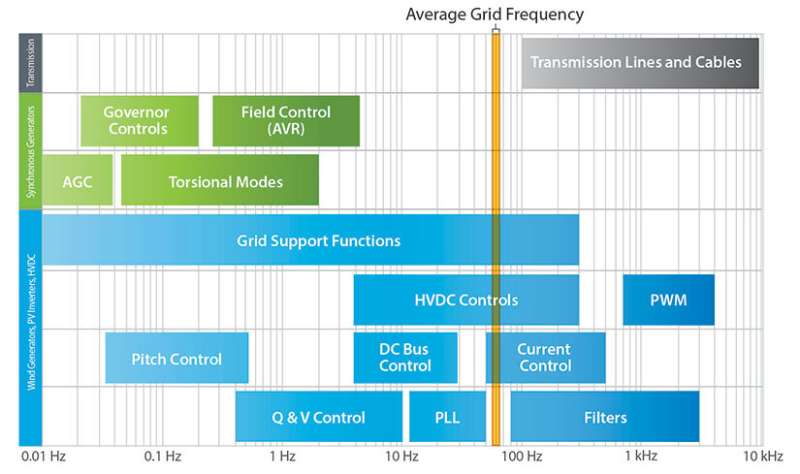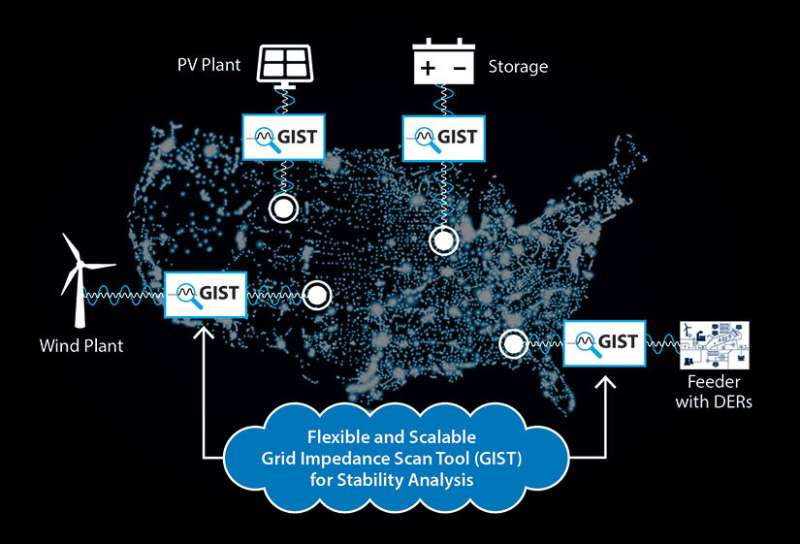Standing among solar arrays and power grid equipment at the National Renewable Energy Laboratory (NREL), you might hear a faint, distorted melody buzzing from somewhere. You are not hallucinating—that gray box really is singing the Star Wars Theme, or the ice cream truck song, or Chopin’s Waltz in A minor. Power system engineers are just having some fun with an NREL capability that prevents stability problems on the electrical grid.
Usually, the engineers send another kind of waveform through the inverters and load banks: megawatts of power and voltage vibrations at many frequencies. The purpose of their research is to see how energy devices and the grid interact—to get them “in tune” and prevent dangerous electrical oscillations that show up like screechy feedback or a booming sub-bass.
The engineers can do this analysis at high fidelity with NREL hardware using the lab’s advanced impedance measurement system, and they have also produced a commercially available software called the Grid Impedance Scan Tool or GIST that can do the same with simulated power on device models, allowing any manufacturer or grid operator to certify grid stability with renewable energy resources.
“These unique capabilities can excite wind turbines, PV inverters, and all this new equipment at different frequencies to understand whether they will be friendly with the grid or there will be some disruptions,” said Shahil Shah, project lead and developer of GIST.
Stability in G major
Like music, electricity is made of waves that interact to create harmonies and distortions. While music spans around 10 octaves, 20 octaves are used by electric power systems with equipment like wind energy and solar power plants. This leaves plenty of room for signals to overlap, resonate, and amplify, which does happen occasionally on electrical systems and appears to be happening more as spinning generators are displaced by power electronics like wind and solar inverters. When rogue oscillations do occur, they can damage components or cause full-on power system failures.
“Solar and wind create a lot of oscillations just like mechanical structures, but we don’t see them. This can create disruptive behavior, and it has happened all over the world in power systems with high levels of renewables,” Shah said.
Stability is tricky because grid designs are different from one system to the next, such that adding a new wind energy or solar power plant is like placing a new musician in a live group without providing them sheet music—they might be off-note no matter how skilled.
For industry partners, NREL provides exactly that capability: to place a device into its true grid environment and see how it “sounds.” NREL’s high-power infrastructure can emulate any electrical grid for partner technologies and can closely measure the technology’s response.
“We develop tools that allow us to quickly switch between frequencies that we are injecting into the grid,” said Przemek Koralewicz, a co-developer of GIST. “And to generate music, we use exactly the same tools.”

The frequency range of grid components expands well beyond the nominal operating frequency of 50 or 60 Hz. When grid controls and components oscillate outside of their expected range, serious stability issues can occur. © Taylor Henry, NREL
Like the singing inverters, a partner’s solar panels, wind turbines, or batteries will perform to the frequencies of the grid. Within this megawatt symphony, engineers can identify and correct where the system is vibrating dangerously.
As more grid operators now insist on preliminary stability assessments for new device connections, real-power demonstrations are becoming more important. But not every grid operator or device manufacturer can visit NREL’s advanced research environment for energy systems to validate their interconnection. An alternative might be to model the systems, but such high-fidelity models are generally not available in an open, transparent format—not for devices nor the grid.
Instead, NREL engineers invented a workaround to check stability with nothing more than desktop software and commonly available black-box models that do not disclose intellectual property of wind and PV vendors.
Software to easily check grid stability
NREL’s GIST software shows that detailed device models are not actually needed; the black-box variety will work just fine. GIST only measures the combined stability of interacting devices, and for that, any model that captures device behavior at its terminals will do. This flexibility allows users to test a far greater range of devices, overcoming all barriers to stability assessments.

The Grid Impedance Scan Tool (GIST) sits between models of devices and the grid, allowing users to scan frequency dynamics and determine where unwanted stability issues could arise. © National Renewable Energy Laboratory
Since grid stability is a collective outcome—a harmony of devices and the grid—it must be assessed at junctions where the two meet. GIST does this by interfacing between device and grid models: devices on one side, electrical grid on the other. The software then injects the combined model with frequencies to see how the system responds. This is called an impedance scan.
A GIST scan could take between a few minutes and several hours, depending on the size of the system and the number of power electronic devices, and it can evaluate multiple devices in parallel. In practice, a user would scan at a variety of points throughout the network to gain a complete view of dynamic stability. Currently GIST is available by license and is being applied in several research partnerships.
The software is especially useful for validating grid-forming controls, which allow renewable energy resources to provide stability in the same way that spinning generators traditionally have. Finding the right mix of grid-forming and grid-following devices will soon preoccupy utilities and system operators everywhere, and GIST can help determine whether a given mix is truly stable. GIST will also complement NREL’s widely collaborative effort to develop grid-forming controls via the UNIFI consortium by providing a tool for researchers to quickly evaluate new technologies and system architectures.
NREL’s inverters may seem to be singing to their own tune, but it is really the melody of broad grid stability. As memorable songs resonate through the laboratory’s power electronics, visitors are reminded that grid frequency is also harmonious or harsh, discordant or dulcet. To ensure that renewable energy has a smooth crescendo on power systems, partners can turn to NREL testing and software tools.
Provided by
National Renewable Energy Laboratory
Citation:
Singing inverters show electrical harmony for renewable power systems (2022, December 14)



